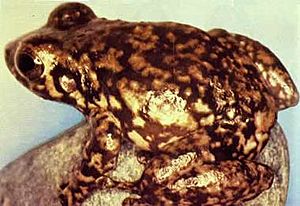Web-footed coquí facts for kids
Quick facts for kids Web-footed coqui |
|
|---|---|
 |
|
| Conservation status | |
| Scientific classification | |
| Genus: |
Eleutherodactylus
|
| Species: |
karlschmidti
|
| Synonyms | |
|
Euhyas karlschmidti (Grant, 1931) |
|
The web-footed coqui is a special kind of frog from Puerto Rico. It's also called the stream coqui or Puerto Rican stream frog. Its scientific name is Eleutherodactylus karlschmidti.
This frog was first found and described in 1931 by a scientist named Chapman Grant. It was named after another scientist, Karl Patterson Schmidt. The web-footed coqui is the biggest Eleutherodactylus frog found in Puerto Rico. Scientists think it might be extinct, meaning there are no more left in the world.
What Does It Look Like?
The web-footed coqui can grow up to about 80 millimeters (about 3.1 inches) long. This measurement is from its snout (nose) to its vent (bottom). It has a strong, chunky body. Its head is wider than its body.
The frog's eyes are big and stick out. It has a small, clear eardrum, called a tympanum. Its legs are strong but quite short. The tips of its fingers and toes have large, round pads called discs.
Unlike many frogs, its fingers do not have webbing between them. But its toes have a lot of webbing. This makes it the only coqui frog with webbed toes!
The skin on its back is bumpy, like it has warts. Its belly skin is smooth. The frog's back is a mix of green, yellow, and black colors. It has a yellow line between its eyes. Another yellow line goes from its lip to its eardrum. There are also some faint bands across its back.
Male web-footed coquis have a special throat pouch. This pouch helps them make loud, clear calls. They use these calls to attract mates.
Where It Lived and Why It's Gone
The web-footed coqui loved to live in mountain streams. It was found at different heights, from about 45 to 630 meters (148 to 2,067 feet) above sea level. It preferred rocky, fast-flowing streams in thick, moist forests.
Male frogs would call out from rocks, riverbanks, and waterfalls. These frogs have a special way of developing. They don't have a tadpole stage that swims freely in the water. Instead, the eggs hatch directly into tiny froglets.
This frog used to be common in eastern Puerto Rico. It also lived in the western mountains, including the El Yunque National Forest. But the last time anyone saw this frog was in 1988. Even though scientists have searched many times, they haven't found any since then.
Scientists believe the web-footed coqui is almost certainly extinct. The main reasons are likely a fungal disease called chytridiomycosis. This disease affects amphibians worldwide. Climate change also played a role. Sometimes, new animals brought into the area, called invasive predators, might have also harmed the frog population.
See also

- In Spanish: Coquí palmeado para niños


